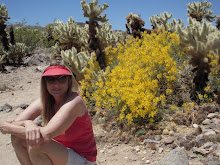
 Twenty years ago, in 1987, the rock band U2 released the mega-selling album, The Joshua Tree, that includes two of my favorite songs, "Where the Streets have no Name" and "I Still Haven't Found what I'm Looking for."
Twenty years ago, in 1987, the rock band U2 released the mega-selling album, The Joshua Tree, that includes two of my favorite songs, "Where the Streets have no Name" and "I Still Haven't Found what I'm Looking for."In the autobiography U2 BY U2, lead guitarist The Edge says that in making The Joshua Tree, the band wanted to create a "cinematic record" in which each song conjured up a physical location, and that the desert and the American Southwestern landscape became recurring lyrical themes. Bono adds, "I wanted something biblical."
During the time The Joshua Tree was being made, the death of stagehand and friend Greg Carroll affected the band members so deeply that his loss added even more emotion to the album, with its haunting guitar riffs, recorded in an old house in the foothills of Ireland's Wicklow Mountains. The album was dedicated to Greg Carroll's memory.
To shoot the album cover, the band traveled with a small crew to Southern California's Mojave Desert. The group drove around for several days and spent the night in motels including the Harmony Motel in Twentynine Palms. They visited Zabriskie Point in Death Valley and drove up to Bodie, a ghost town near Mono Lake in northern California.
As the band and crew toured the desert landscape, they all wondered what the funny, prehistoric cactus they saw everywhere were. Intrigued by the name--the Joshua tree--Bono decided to photograph the plants. The album's cover shows band members Bono, The Edge, bass player Adam Clayton, and drummer Larry Mullen Jr. in the Mojave Desert posing with a Joshua tree. Rumor has it that the band did not want to photograph a Joshua tree in the national park to protect the area from fans who in their enthusiasm might damage the surrounding terrain.
The Joshua Tree was released on March 9, 1987 and within a week climbed to number one on music charts worldwide. The album put U2 on the cover of Time magazine, was named Album of the Year at the Grammys, became a number one album and produced two number one singles in the U.S. charts. The band toured for two years following The Joshua Tree. U2 remember the period as a dizzying time in reaction to the public's unexpected and overwhelming response to their new work.
This year, to commemorate the album's 20th anniversary, U2 released the remastered The Joshua Tree 2007 that includes bonus materials such as a live concert DVD shot in Paris in 1987 and unseen photography from Anton Corbijn, who shot the album's original cover.
Besides making amazing music, U2 has raised the profile of the desert icon, the Joshua tree. For more information about the new release, or to find out more about the band check out http://u2.com/
desert trivia: the Joshua tree is said to have been named by Mormon pioneers who, when they first encountered the gangly yucca, thought it looked like the prophet Joshua leading the way to the Promised Land
(photos: from The Joshua Tree; U2 BY U2
During the time The Joshua Tree was being made, the death of stagehand and friend Greg Carroll affected the band members so deeply that his loss added even more emotion to the album, with its haunting guitar riffs, recorded in an old house in the foothills of Ireland's Wicklow Mountains. The album was dedicated to Greg Carroll's memory.
To shoot the album cover, the band traveled with a small crew to Southern California's Mojave Desert. The group drove around for several days and spent the night in motels including the Harmony Motel in Twentynine Palms. They visited Zabriskie Point in Death Valley and drove up to Bodie, a ghost town near Mono Lake in northern California.
As the band and crew toured the desert landscape, they all wondered what the funny, prehistoric cactus they saw everywhere were. Intrigued by the name--the Joshua tree--Bono decided to photograph the plants. The album's cover shows band members Bono, The Edge, bass player Adam Clayton, and drummer Larry Mullen Jr. in the Mojave Desert posing with a Joshua tree. Rumor has it that the band did not want to photograph a Joshua tree in the national park to protect the area from fans who in their enthusiasm might damage the surrounding terrain.
The Joshua Tree was released on March 9, 1987 and within a week climbed to number one on music charts worldwide. The album put U2 on the cover of Time magazine, was named Album of the Year at the Grammys, became a number one album and produced two number one singles in the U.S. charts. The band toured for two years following The Joshua Tree. U2 remember the period as a dizzying time in reaction to the public's unexpected and overwhelming response to their new work.
This year, to commemorate the album's 20th anniversary, U2 released the remastered The Joshua Tree 2007 that includes bonus materials such as a live concert DVD shot in Paris in 1987 and unseen photography from Anton Corbijn, who shot the album's original cover.
Besides making amazing music, U2 has raised the profile of the desert icon, the Joshua tree. For more information about the new release, or to find out more about the band check out http://u2.com/
desert trivia: the Joshua tree is said to have been named by Mormon pioneers who, when they first encountered the gangly yucca, thought it looked like the prophet Joshua leading the way to the Promised Land
(photos: from The Joshua Tree; U2 BY U2
Harmony Motel, 2006 (missing two musical notes from the sign)

No comments:
Post a Comment